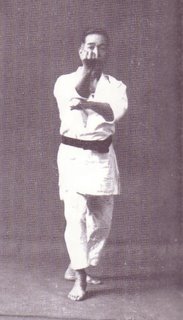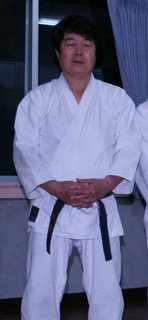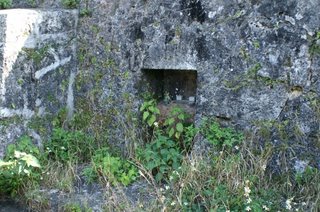A Family Affair
 Karate was a family affair.
Karate was a family affair. In the late 19th Century, two eminent disciples of Matsumura Sokon became fast friends – Tawada Shinkazu and Itosu Ankoh. Both became prominent men. Itosu – a peichin – rose to soushi koori, personal secretary to the king and administrator of udon, the class of wealthy landowners who were equivalent to daimyo on mainland
With so much in common, it should come as no surprise that these men were related to each other. Born between 1830-1832, Itosu was Tawada’s senior by approximately 20 years (5). Itosu’s chonan or first born son, therefore, would have been approximately the same age as Tawada or perhaps slightly younger. Tawada introduced his younger sister to Itosu’s chonan, and the two later married. While both were peers under Matsumura, it was this introduction and subsequent marriage of Itosu’s chonan that led to Itosu and Tawada’s fast friendship.
While the time frame is unclear, Chibana’s oldest sister caught Tawada’s eye, and the two married. Perhaps after some friendly nudging from his new wife, Tawada took his new brother-in-law, Chibana, under his wing and also began to train him.***
Chibana must have made an impression; between 1899-1900, Chibana was introduced to Itosu through Tawada. At age fifteen, Chibana left Okinawa Kenritsu Dai-ichi Chugakko and with a recommendation letter from his brother-in-law, became a full-time disciple of Itosu. While Itosu became Chibana’s main instructor, with the encouragement and approval of Itosu, Chibana continued to see and train with Tawada.
Chibana’s sai-justu was undoubtedly strong as he learned the use of the sai from Tawada. But, the most famous of Tawada’s teachings to Chibana was matsumura patsai. Itosu had created his own patsai kata, which is preserved today as patsai sho amongst most Shorin schools and derivatives. A popular story circulates that when Chibana wanted to learn the Matsumura version, Itosu sent him to Tawada. Chibana learned matsumura patsai from Tawada, returned to Itosu, and demonstrated the kata. Chibana’s performance of matsumura patsai impressed Itosu so much that Itosu encouraged Chibana to retain the kata and preserve it for future generations.
Chibana must have impressed both masters greatly. One of Funakoshi Gichin’s instructors, Azato Ankoh, said, “From ancient times, people appreciated the difficulty of being a teacher to one’s own child, and so it was common practice to exchange children, letting others look after the education of one’s children and vice versa.” (6) This was not, however, something taken lightly. Tawada sent his son to Chibana to learn karate, indicating a great degree of trust and respect for Chibana’s skills and prowess. Chibana became the dai-sempai of the Itosu dojo in Itosu’s latter days, somewhere between 1910-1915. As mentioned in the previous article, “Busy, Busy, Busy,” dai-sempai-ship in the Itosu dojo was also not a matter taken lightly. Chibana assumed teaching duties in the dojo by running classes and handled all would-be challengers.
Both masters also must have made a deep impression on Chibana. Chibana diligently preserved the patsai kata he learned from Tawada, specifically selecting and revealing this kata to mainland
The Itosu monument in Makabe, Naha, Okinawa.
In his last days, Chibana chose his grandson, Nakazato Akira, to succeed him as ato-tsugi and continue his Okinawa Shorin Ryu Karatedo Kyoukai. Chibana sent both Akira and Akira’s elder brother, Jiro, to train under one of Chibana’s American students whom Chibana had just awarded a shihan teaching license in 1965. Though Akira did not become the successor as planned following Chibana’s death in 1969, Akira continued to train his grandfather’s karate until between 1979-1981 when he passed the mantle to an Okinawan named Higa. Higa trained and passed on his teachings to an Okinawan named Isa. Isa continues to propogate a version of Chibana karate to this day (9).
Chibana was laid to rest in the Tawada family plot where he remains to this day. Throughout his life, karate had been a family affair; from his beginnings with his brother-in-law Tawada to his succession of karate from Itosu, his master and relative from intermarriage.
The final resting place of Chibana Choshin...and to the immediate right....
the final resting place of Tawada Shinkazu "Megantu" Peichin
Notes:
(1) Nagamine Shoshin, Tales of Okinawa's Great Masters, (Boston: Tuttle Martial Arts, 2000), pg. 47.
(2) Funakoshi Gichin, Karate-Do: My Way of Life, (Tokyo: Kodansha Int'l, 1975), pg. 10.
(3) John Sells, Unante, 2nd Edition (Hollywood: W.M. Hawley Library, 2000), pg. 56.
(4) Talk with Mr. Masahiro Nakamoto, head of the Bunbukan Dojo and Karate Museum in Tori Hori, Shuri, Okinawa. "Megantu" is hogen for "hair over eyes" (a very rough translation) in reference to long bangs that completely cover the forehad and hang down close to or over a person's eyes (see some of Jackie Chan's first movies to get an idea of what I'm talking about). Tawada is also known as "Ta-ta" or "Ta-da", a hogen nickname from his students and peers who favored abbreviating his name by saying it quickly. "Shinkazu" is also most likely a Japanization of "Shimbuku."
(5) Hokama Tetsuhiro, Karatedo Rekishi Nenpyou, (Okinawa: Okinawa Book Center, 2001), pg. 24.
(6) Gichin Funakoshi, Karatedo Nyumon, (Tokyo: Kodansha Int'l., 1988), pg. 32.
(7) Pgs. 28-34 are pictures of then 53 year-old Chibana performing "kata patsai (matsumura-ha)." Pgs. 239-264 are detailed sketches of the kata with bunkai of the movement. Sells argues that the patsai Chibana learned from Tawada is properly Tawada-patsai, suggesting significant differences from the true Matsumura-patsai. These differences may not be deliberate or intentional as in Itosu's creation of his own patsai, but are probably due to habits, individual body mechanics, and different preferences between Matsumura and Tawada.
(8) Nagamine, pg. 45
(9) Isa began training shortly after Chibana's death, but he first met Chibana as a boy. Isa recalls his encounter with Chibana vividly: he was playing outside in the front yard of his home when Chibana stopped by to visit his father. Chibana wore a suit with a hat, and he stopped at the gate near Isa, removed his hat, and bowed to him. He humbly asked Isa's permission to enter and then asked Isa's permission to speak to his father, keeping his head lowered in a formal fashion. Isa was awed that such a man would lower his head and bow to him, a mere boy, and ask his permission. Isa says, "I knew I was in the presence of greatness."
I've decided to go with the Asian way of names with family name first followed by first name. Trying to transform everyone's names western style with all of the stuff I'm reading is a bit of a headache. I've also decided to go with Chibana Choshin instead of Chibana Chosin for similar reasons.
Edit and Post Post Script:
Tawada introduced his younger sister to Itosu's chonan, NOT his cousin. Imouto and itoko sound similar if you say them fast enough... I've since corrected the mistake above.
***This paragpraph has been edited from a previous version since I have been unable to relocate the source from which I drew previous facts concerning Chibana and his sister learning under Kiyuna Taro.





6 Comments:
Excellent work, as always.
Do you ever think of submitting to one of the martial arts magazines? Uh, the good ones, that is.
I'm not sure. I don't think what I'm doing is quite THAT good. I'm just piecing together stuff that's been out in books for a while already. My only extra edge are the pictures since I actually went to Okinawa to visit these places.
I love your site. Chibana Dai-Sensei has always been a favorite charater of mine from karate history. Thank-you also for explaining and posting the origins of Passai sho & dai. I now have a place to refer people to regarding it's history.
I am just curious, is Nakazato Akira related to Nakazato Shuguro?
Nakazato Akira and Nakazato Shuguro are not related as far as I know. Nakazato Akira is the son of Chibana Sensei's daughter Yoko from his first marriage.
Thanks for putting all the effort into gathering and publishing this site. The information on your site is very interesting and well writen, I was wondering if you could expand a bit on the details around "1981 when he passed the mantle to an Okinawan named Higa". Which Higa is this? What dojo is Mr. Isa running?
Thanks again.
Did the Kata "Chibana No Sai " come from the Chibana Family?
Post a Comment
<< Home